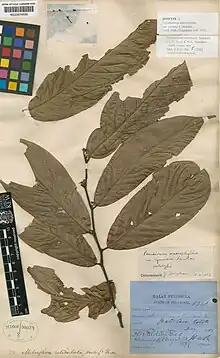Pseuduvaria cymosa
Pseuduvaria cymosa is a species of plant in the family Annonaceae.[2] It is native to Peninsular Malaysia.[1] James Sinclair, the Scottish botanist who first formally described the species using the synonym Pseuduvaria macrophylla var. cymosa, named it after its branched inflorescences which are called cymes.[3]
| Pseuduvaria cymosa | |
|---|---|
 | |
| Herbarium specimen of Pseuduvaria cymosa.[1] | |
| Scientific classification | |
| Kingdom: | Plantae |
| Clade: | Tracheophytes |
| Clade: | Angiosperms |
| Clade: | Magnoliids |
| Order: | Magnoliales |
| Family: | Annonaceae |
| Genus: | Pseuduvaria |
| Species: | P. cymosa |
| Binomial name | |
| Pseuduvaria cymosa | |
| Synonyms | |
|
Pseuduvaria macrophylla var. cymosa J.Sinclair | |
Description
It is a tree reaching 18 meters in height. Its elliptical, moderately leathery leaves are 14.5-23 by 4-10 centimeters. The leaves have blunt bases and tapering tips, with the tapering portion 6-14 millimeters long. The leaves are hairless on their upper and lower surfaces except for the midrib which can be sparsely hairy. The leaves have 14-18 pairs of secondary veins emanating from their midribs. Its densely hairy petioles are 5-9 by 1.5-3 millimeters with a broad groove on their upper side. Its Inflorescences are solitary or occur in pairs and are organized on 2-4 millimeter-long, densely hairy peduncles. Each inflorescence has up to 4 flower. Each flower is on a densely hairy pedicel that is 5-15 by 0.5-0.9 millimeters. The pedicels are organized on a rachis up to 5 millimeters long. The flowering pedicels have a medial, densely hairy bract that is 0.5-1 millimeters long. The flowers are unisexual. Its flowers have 3 triangular sepals, that are 1.5 by 1.5-2.5 millimeters. The sepals are hairless on their upper surface, and sparsely hairy on their lower surface. Its 6 petals are arranged in two rows of 3. The red to yellowish-purple, oval, outer petals are 2-2.5 by 2.5-3.5 millimeters with hairless upper surfaces and densely hairy lower surfaces. The red to yellowish-purple, triangular, inner petals have a 1.5-3 millimeter long claw at their base and a 4-6.5 by 3-3.5 millimeter blade. The inner petals have pointed tips and wedge-shaped bases. The upper and lower surfaces of the inner petals are mostly hairless. There is a solitary, smooth, elliptical gland on the upper surface of the inner petals.Male flowers have up to 65 stamens that are 0.8-1 by 0.5 millimeters. Female flowers have up to 13 carpels that are 1.6-1.8 by 0.8-0.9 millimeters. Each carpel has 4 ovules arranged in a single row. The female flowers have up to 9 sterile stamen.The fruit occur in clusters of 1-8 and are on sparsely hairy pedicles that are 15-30 by 1-3 millimeters. The mature fruit are round and 5-16 by 5-15 millimeters. The mature, smooth, densely hairy fruit have a sharp point that is 0.3-0.4 millimeters long. Each fruit has up to 2 seeds. The wrinkled, spherical seeds are 9-9.5 by 8.5 by 4.5-5.5 millimeters.[4]
Reproductive biology
The pollen of P. cymosa is shed as permanent tetrads.[5]
Habitat and distribution
It has been observed growing near streams.[4]
References
- "Pseuduvaria cymosa (J.Sinclair) Y.C.F.Su & R.M.K.Saunders". Plants of the World Online. The Trustees of the Royal Botanic Gardens, Kew. n.d. Retrieved July 1, 2021.
- "Pseuduvaria cymosa (J. Sinclair) Y. C. F. Su & R. M. K. Saunders". Catalogue of Life. Species 2000. n.d. Retrieved July 1, 2021.
- Sinclair, James (1955). "A Revision of the Malayan Annonaceae". The Gardens' Bulletin, Singapore. 4. 14 (2): 149–516.
- Su, Yvonne C.F.; Saunders, Richard M.K. (2006). Monograph of Pseuduvaria (Annonaceae). Systematic Botany Monographs. Vol. 79. American Society of Plant Taxonomists. pp. 1–204. JSTOR 25027955.
- Su, Yvonne C. F.; Saunders, Richard M. K. (2003). "Pollen structure, tetrad cohesion and pollen-connecting threads in Pseuduvaria (Annonaceae)". Botanical Journal of the Linnean Society. 143 (1): 69–78. doi:10.1046/j.1095-8339.2003.00204.x. ISSN 1095-8339.